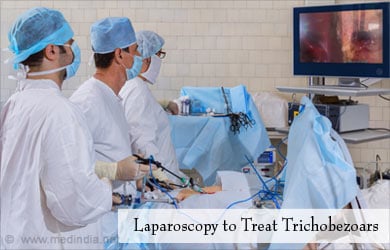- Eng K, Kay M. Gastrointestinal Bezoars: History and Current Treatment Paradigms. Gastroenterology & Hepatology. 2012;8(11):776-778.
- S. Mewa Kinoo and B. Singh, “Gastric Trichobezoar: An Enduring Intrigue,” Case Reports in Gastrointestinal Medicine, vol. 2012, Article ID 136963, 3 pages, 2012 - (doi:10.1155/2012/136963)
- Iwamuro M, Okada H, Matsueda K, et al. Review of the diagnosis and management of gastrointestinal bezoars. World Journal of Gastrointestinal Endoscopy. 2015;7(4):336-345 - (doi:10.4253/wjge.v7.i4.336.)
- Gorter RR, Kneepkens CMF, Mattens ECJL, Aronson DC, Heij HA. Management of trichobezoar: case report and literature review. Pediatric Surgery International. 2010;26(5):457-463 - (doi:10.1007/s00383-010-2570-0.)
- Gaujoux S, Bach G, Au J, et al. Trichobezoar: A rare cause of bowel obstruction. World Journal of Gastrointestinal Surgery. 2011;3(4):54-55 - (doi:10.4240/wjgs.v3.i4.54.)
- J Carvajal Balaguera, M Martín García-Almenta, J Iborra Herrera, L Albeniz Aquiriano, J Camuñas Segovia, C Cerquella Hernandez. Giant Gastric Trichobezoar In A Female Teenager. The Internet Journal of Surgery. 2008 Volume 21 Number 2. - (doi:10.4253/wjge.v7.i4.336.)
What are Trichobezoars?
The first thought that comes to your mind when you hear the word ‘Trichobezoar’ is that it may be the name of a prehistoric dinosaur!! However, the name actually indicates a rare condition where a hairball is found in the stomach or gastrointestinal tract. “Trich” of trichobezoar is a Greek word which indicates hair and “bezoar” is from a Persian word “Panzehr” or an Arabic word “badzehr” that means an antidote. During the period between the 12th and 18th centuries, badzehr was a clump or mass of animal material that was given to cure conditions, such as poisoning, epilepsy, snake bite, among others. However, by the 16th century, Ambroise Paré, a famous surgeon, noted that bezoars could not heal against all poisons. Baudamant, a French physician first described a case of trichobezoar in a boy of 16 years.
In some cases, hairballs extend from the stomach into the small intestines or even the colon; this condition is called “The Rapunzel syndrome”. This syndrome was first described by Dr. Vaughan and his group in 1968.
Trichobezoars are most frequently observed in females and are associated with a psychiatric disorder, such as trichotillomania that involves an urge to pull one’s hair out and consume it. Human hair is difficult to digest due to its resistance to digestive enzymes. The hair gets caught and mixed with mucus and food within the folds of the stomach to form a compacted oval mass or a hairball. Trichobezoars develop very slowly and sometimes may take many years to develop.
What are the Causes of Trichobezoars?
Trichobezoar or an indigestible hair mass in the abdomen results from the accidental or involuntary ingestion of hair. One of the main causes of trichobezoars is the psychiatric condition of trichotillomania. In trichotillomania, the individual involuntarily or unconsciously has an irrepressible urge to pull out his/her hair before swallowing it. Other psychiatric disorders that can cause trichobezoars are obsessive compulsive disorders anorexia, pica, and depression. Gastric surgery, e.g. gastroenterostomy and bariatric surgery is one of the predisposing conditions to trichobezoars.
What are the Symptoms and Signs of Trichobezoars?
In many cases, when the mass is small, a trichobezoar may not be identified due to the lack of symptoms. The initial symptoms of trichobezoar may include loss of appetite and nausea. When the trichobezoar is significant in size, it can cause obstructive symptoms. Also, due to the pressure it exerts, it can reduce blood supply to the stomach and intestine resulting in ulcers and perforation of these organs. Jaundice and pancreatitis can occur as complications. Some of the symptoms caused by trichobezoars are as follows:
- Exhaustion or fatigue
- Stomach pain
- Bad breath
- Vomiting
- Black tarry stools due to bleeding
- Discomfort in the chest
- Patchy loss of hair, which may be indicative of trichotillomania
- Dizzy feeling
- Constipation or diarrhea
- Loss of weight

The severity of symptoms depends on the seriousness of the condition. For example, a patient with perforation may be in shock due to loss of blood.
How are Trichobezoars diagnosed?
Trichobezoar may be suspected based on history and clinical examination of the patient. A mass may be felt over the abdomen on physical examination.
- Trichobezoars are linked to psychiatric disorders and hence clinical assessments are necessary to understand the possibility of the presence of hairballs.
- Radiological tests include gastrointestinal endoscopy, ultrasonography, x-ray of the abdomen, and computed tomography of the abdomen. Computed tomography scans of the abdomen are extremely accurate and are therefore preferred in the diagnosis of trichobezoar. If an individual has suffered from trichobezoars in the past, it is recommended that he/she get a scan done twice a year to detect any recurrence.

How are Trichobezoars treated?
Surgery is the preferred choice of treatment since medications are ineffective in dissolving a trichobezoar.
There are 3 main surgical ways to treat trichobezoars:
Laparotomy or Open Surgery: This is a favorable form of treating trichobezoars. The procedure is low in complications and can detect any secondary masses in the abdomen or intestine. This is the only form of treatment for Rapunzel syndrome.
Laparoscopy: Nirasawa and colleagues first described this form of treatment for bezoars in 1998. Laparoscopy or keyhole surgery is normally combined with endoscopy. While laparoscopy is used to fragment the hairball, endoscopy is utilized to remove the fragments. Complications are minimal with this procedure and patients are discharged quickly. However, laparoscopy takes a longer time as compared to open surgery.

Endoscopy: Endoscopy is not a preferred method to treat trichobezoar though it may be used for diagnosis or in combination with laparoscopy.
Prevention of Trichobezoars
Individuals who have had trichobezoars should get an abdominal scan done twice a year to diagnose any recurrence. Patients should be clinically evaluated to identify psychiatric conditions that cause them to eat their hair and should be treated for the same.






